#yuiwata
Explore tagged Tumblr posts
Text
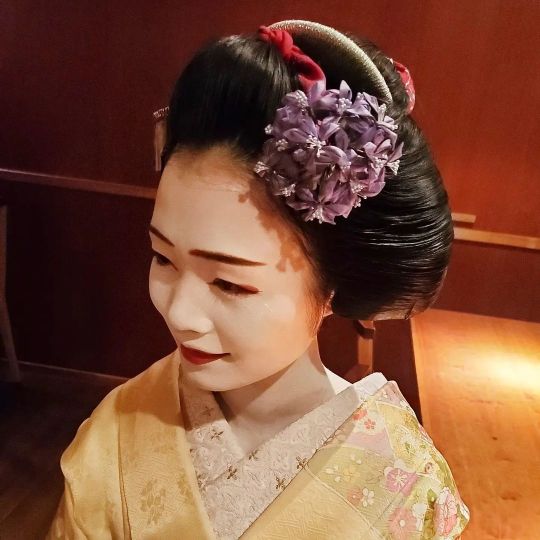

Waka 和香 from Kagurazaka has become a senior Hangyoku in September! You can see she is wearing a collar without red embroidery, a different set of Hana kanzashi than last September (more subdued colour), and the Yuiwata hairstyle opposed to Momoware/Wareshinobu, which she wore earlier. Waka is currently in her second year as Hangyoku, she debuted in May 2023.
39 notes
·
View notes
Note
What's the cloth that's wrapped around the bun here
https://pin.it/5p55Mc2FA
The cloth used in the yuiwata hairstyle shown there is called an Arimachi Kanoko (ありまち鹿の子) ^^
6 notes
·
View notes
Photo






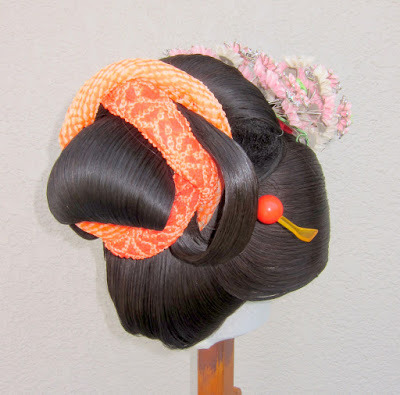


Source: http://nihongami.blogspot.com/2019/09/blog-post_18.html
Japanese Hairstyles: Historical Overview Part 02: Women’s Hairstyles of the Edo Period, Part 03
Hairstyle Name: Kikugasane (菊重ね) lit. “Chrysanthemum Layers”
This hairstyle is a combination of the Yuiwata (ゆいわた) and Ichougaeshi (���杏返し). In this style, the topknot has the rounded portion behind the the forelocks and the tail (just like the Yuiwata), but has two loops of hair (just like the Ichougaeshi) coming out perpendicular to the topknot. Then, a piece of loosely bound cotton (or brocade) is tied around the loops of the topknot where they intersect.
Today, is worn by maiko during Setsubun or by the senior maiko of Pontocho as part of a series of hairstyles signifying the arrival of her erikae. In the Edo period, it was probably worn by single town girls between the ages of 17-19 years old. It was never worn by women of the samurai or court noble classes.
#kimono#nihongami#kikugasane#kikukasane#yuiwata#ichogaeshi#ichougaeshi#shimada#shimadamage#nihongamitimeline#nihongamitimeline03#nihongamitimeline03e
19 notes
·
View notes
Photo


Image Source: https://twitter.com/nadeshicorin/status/1063967305128767488
Information Source: https://koikishu.tumblr.com/tagged/yuiwata
Hairstyle Name: Musubu-nishiki (結錦) lit. “Bound Brocade” // Yuiwata (ゆいわた) lit. “Bound Cotton”
This hairstyle is a variation of the Tsubushi-shimada. In this style, a large twisted knot is created over the bun, which is the largest focal point at the front of the topknot. It was never worn by women of the samurai or court noble classes. It was worn by single town girls between the ages of 9-19 years old. This hairstyle was popular with young girls until the early Meiji era (~1872) and it seems that in Kyoto it was tied until around the Meiji era 20 (~1887).
It seems the young girls felt very glamorous because of the volume created by the twisted knot. The more common name, "yuiwata,” came about because the “brocade” that was being tied to the topknots was actually dyed cotton. Compared to the Taka-Shimada mage, this style was considered “iki” or chic.
9 notes
·
View notes
Photo

กุมภาพันธ์ 2562: ไมโกะ Toshiemi (โอกิยะ Komaya) จากเขต Miyagawacho ในจังหวัด Kyoto
Source: @sa_chi_7474 on Twitter
4 notes
·
View notes
Photo

February 2018: Maiko Kanohiro (Kanoya Okiya) of Gion Higashi performing a dance, while Geiko Tsunekazu (Shigenoya Okiya) plays the shamisen and sings.
Source: Takaaki Tsuruta on Instagram
#kanohiro#tsunekazu#gion higashi#kimono#hikizuri#furisode#susohiki#obi#darari obi#obiage#oshiroi#makeup#yuiwata hairstyle#yuiwata#hairstyle#hair#kanzashi#daikin#hairpin#hair ornament#comb#kushi#kusudama kanzashi#geisha#maiko#geigi#geiko#kanoya okiya#shigenoya okiya#houmongi kimono
111 notes
·
View notes
Photo
A couple of weeks ago, I collected material to understand the style of Shimoda's Geisha better. The wig in question is actually closer to Shimoda's style than Mukojima's.

76 notes
·
View notes
Photo


Setsubun 2017: maiko Fumiyoshi with a celebratory Yuiwata hairstyle by @YOSHIFUMI01 on Twitter
194 notes
·
View notes
Text
Setsubun Maiko Hairstyles
Setsubun, held in early February, marks the start of the new year in the lunar calendar. Geiko and maiko celebrate the lunar new year by dancing for the Shinto gods and goddesses at shrines (Yasaka for Gion Kobu, Gion Higashi, Miyagawacho and Pontocho; Kamishichiken celebrates at Kitano Tenmangu) and dressing up and performing skits (obake). A special privilege for senior maiko–and junior maiko, if their okaasan allows it–is wearing hairstyles they normally can’t wear the rest of the year. The exception to the rule is Pontocho, whose maiko wear these hairstyles, excluding fukiwa and tayū styles, before their sakkou period. For this year’s Setsubun I decided to put together a list of these hairstyles.
Clicking on the name of the hairstyle will redirect you to the photo’s source. Much of the information on the styles comes from ShotaKotake’s nihongami tutorials on DeviantArt. I highly recommend checking them out; they have information on a range of traditional hairstyles for men and women.
Finally, a special thank-you to @missmyloko, who edited this post for me!
Osome

This one is typically worn only by junior maiko, but occasionally senior maiko may wear it. It can be worn with or without miokuri (curled strips of ribbon) attached under the mage (”mass of hair”, what we might call the bun or topknot). Tayū may wear a larger version of this style. This style was mostly likely invented by a courtesan with the same name.
Oshidori no Hina

Originally developed from the yuiwata style, this hairstyle is supposed to resemble the plumage of a young male Mandarin duck. It was popular for new wives in Kyoto and Osaka during the Meiji (1868-1912) and late Edo Period (1600-1868).
Oshun

Kikugasane

A version of the shimada-mage, similar to the yuiwata hairstyle, created in the late Edo Period (1600-1868) to early Meiji Period (1868-1912). This woman runs a wonderful traditional hairstyle and clothing blog. Check it out to see more hairstyles!
Osafune

It can be worn with or without a piece of cloth wound through the mage.
Fukiwa
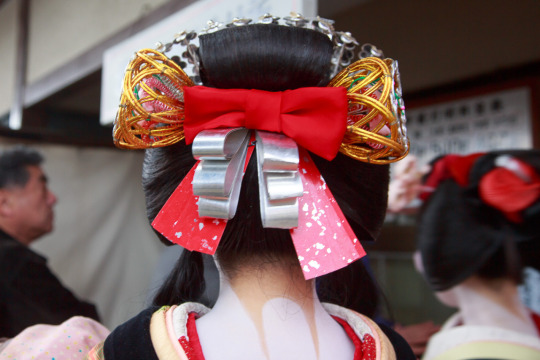
Some say this style was worn by princesses in the Edo Period (1600-1868), others say it was designed as part of a princess costume for the theater. It can be worn with or without miokuri.
Suisha

A version of the tsubushi-shimada, created in the Meiji Period (1868-1912). It can be worn with or without a piece of cloth wrapped around the mage. Supposedly this is one of the most difficult shimada styles to create. It closely resembles the Edo sakkou hairstyle.
Yuiwata

Another version of the tsubushi-shimada, popular with single women in the middle Edo Period (1600-1868).
Marumage
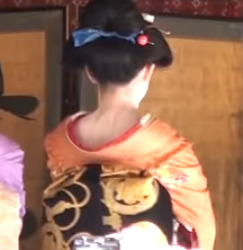
It’s a bit difficult to tell what exactly this hairstyle is, but it most closely resembles marumage, which was worn by women in their mid-20s. Marumage was the most popular version of the shimada hairstyle throughout the Edo (1600-1868) to Meiji (1868-1912) period.
Tayū (courtesan) hairstyles
These are hairstyles or variations of hairstyles worn by tayū or courtesans. They are very ornate, elaborate, and in my opinion absolutely stunning.
Yoko-hyogo

Developed in the mid-Edo Period (1600-1868) from the similar tate-hyogo style. Worn by high-ranking prostitutes–but not tayū–in the Yoshiwara and Shimabara red-light districts. Yoshiwara oiran (the highest rank of prostitute) wear a bigger version of of this style, the date-hyogo. (The original link to the image is missing.)
Tayū ofuku


Tayū ofuku replaces the tegara in maiko ofuku with two different colored pieces of cloth. The mage is also much higher. This hairstyle can take up to 3 hours to create. When maiko wear this hairstyle for setsubun they don’t add the tasseled flower kanzashi seen here.
683 notes
·
View notes
Text
The look of... VII: Mukojima
Welcome to the 18th installment of this series (my 7th). This time, we’re having a look at the Geigi that work in one of Tokyo's Hanamachi: Mukojima (向島).

Historical context Geisha started to live in Mukojima in the early Meiji period (1868-1912) [1]. From the Edo to Meiji period, Mukojima was a recreational area for the common people, and was frequented by Yanagibashi and Yoshiwara Geisha with their customers. [3] The earliest record of a Mukojima Geisha (known to me) is Omomo お百, who was featured in "Contemporary Beauties", 1897 [2]. In 1906, 30 Geisha lived in the area. By 1928, their number had increased to 239. In 1940, several Kenban united, further increasing the number of Mukojima Geisha to 1300. Like in all Hanamachi around Japan, their number declined steadily after the second world war. In 1951, their number was 600, in 1993 240 [7], in 1996 170, in 2007 120 [3], in 2020 around 90 [4]. This makes Mukojima approximately as populated as Gion Kobu and Tokyo's largest Hanamachi.

The look of Mukojima Geiko. Local Term: Geisha 芸者 ※ Hairstyle: Taka shimada, Tsubushi shimada ※ Kanzashi: Kushi, Maezashi, Hirauchi or Tama in the back, rice husk in the new year period ※ Makeup: Oshiroi ※ Kimono: everyday Kimono: Homongi. Kuromontsuki Hikizuri mostly in the new year period or for Erikae, rarely non-black Hikizuri. ※ Haneri: white ※ Obi: Taiko musubi, Yanagi musubi with Kuromontsuki Hikizuri, Tsunodashi musubi with other Hikizuri ※ Obijime: mostly light-coloured. No obijime with yanagi musubi ※ Obiage: mostly red, pink, or white. Seldomly turquoise, white/green, white with red shibori (red/red-white shibori with Kuromontsuki) ※ Footwear: mostly Zori, also Geta

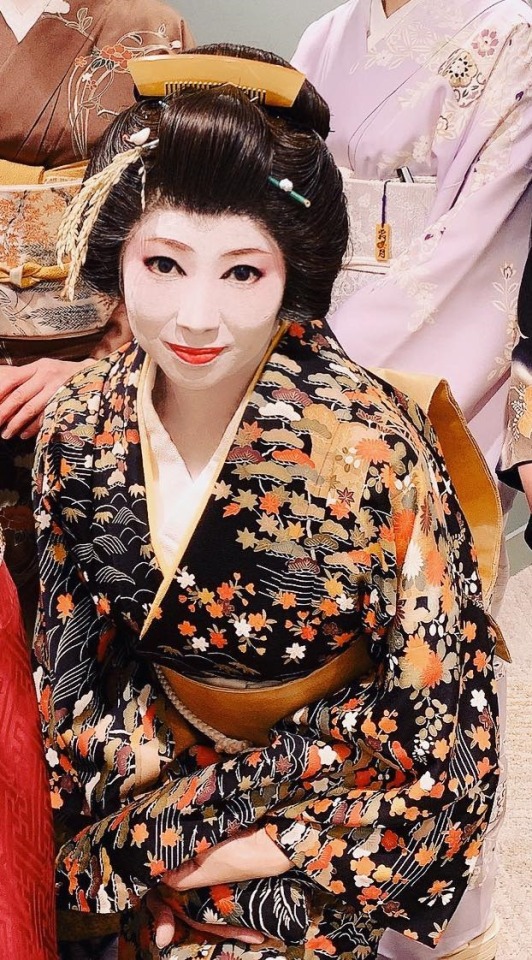
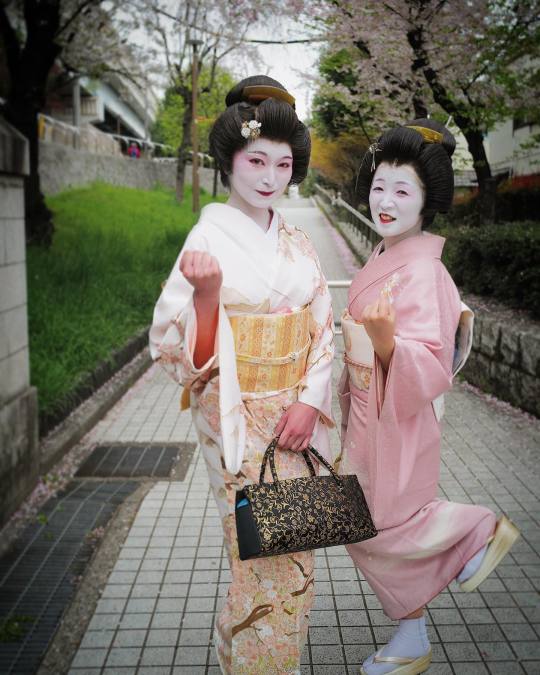
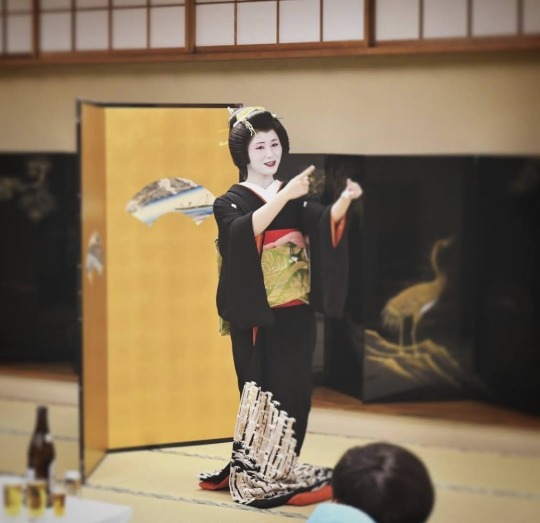
Casual/Jikata look ※ Hairstyle: Yohatsu ※ Kanzashi: none ※ Makeup: western makeup ※ Kimono: Homongi, Kurotomesode ※ Eri: white ※ Obi: Taiko musubi ※ Obijime: mostly light-coloured. In rare cases with pocchiri ※ Obiage: white with red shibori, pink, white, pink/turquoise ※ Footwear: Zori
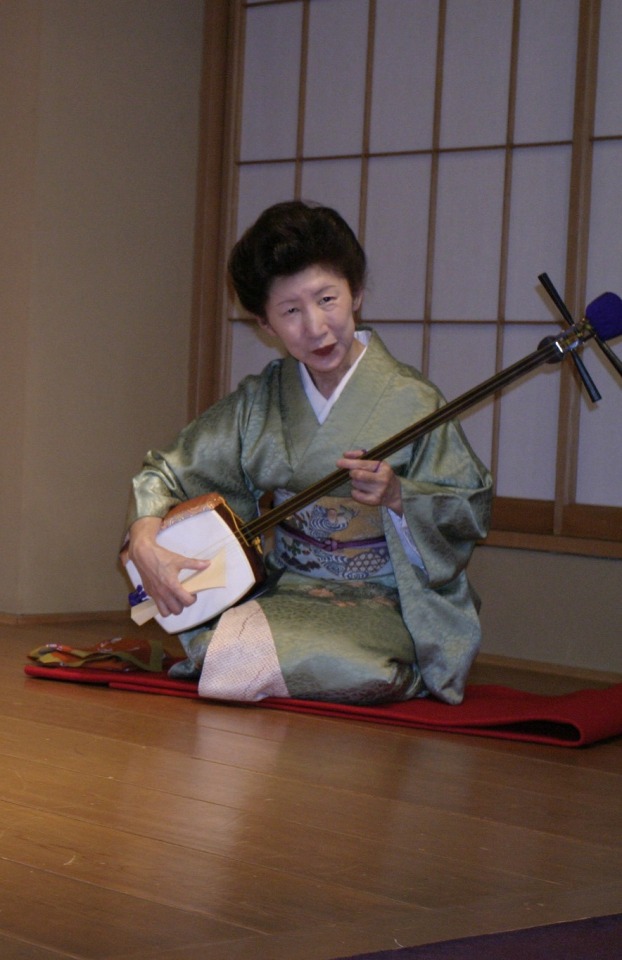
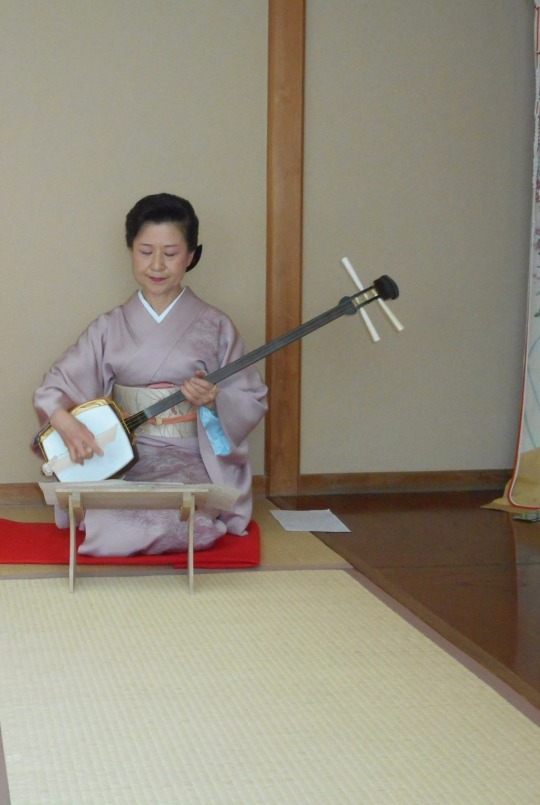

The look of Mukojima Maiko. Local term: Hangyoku 半玉 ※ Hairstyle: Momoware (own hair or wig), Yuiwata for senior Hangyoku (only wig). Shibori, Kanoko and Chinkoro are mostly red, but can also be pink during summer. ※ Kanzashi: seasonal flower kanzashi (1-2 Daikan, Katsuyama, 1-2 Bira-Ôgi, Shidare popular during the entire apprenticeship), Maezashi (optional), Hirauchi. Minimal flower kanzashi with Yuiwata. ※ Makeup: Oshiroi, both lips painted from the start ※ Kimono: Furisode with or without tucks (all variations possible) ※ Eri: mostly white or red/white. But also pink/red, red/purple/green on white base, pink, green, black/pink/white, etc., etc. ※ Obi: kôken musubi ※ Obijime: light-coloured. sometimes with pocchiri ※ Obiage: most common colour variations are red/silver, or red/white shibori. But there are many other combinations. ※ Footwear: mostly Okobo (with red or pink straps), Zori
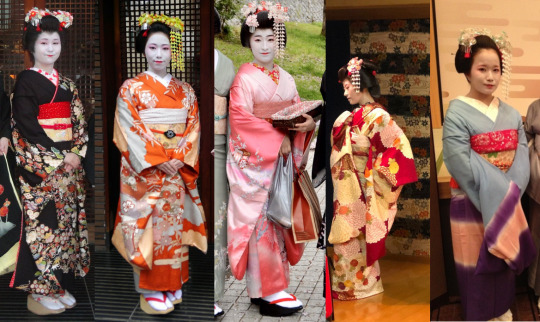
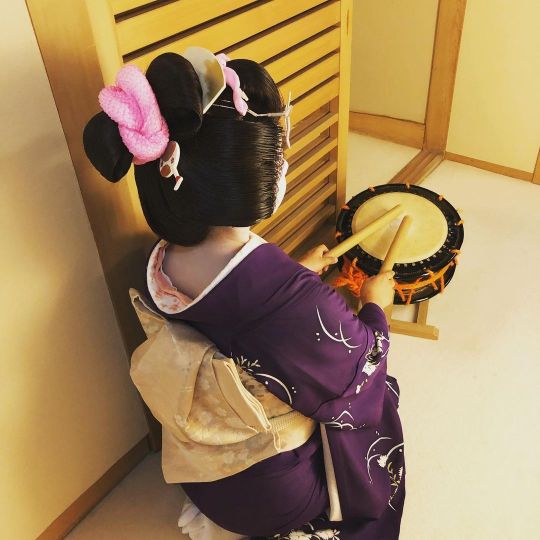



Dances [6] Some dances that are local speciality of Mukojima: ※ Asazuma bune かさずまぶね ※ Fuji musume 藤娘 ※ Fukagawa Kuzushi 深川くずし ※ Gorô ごろう ※ Mukojima ondo 向島音頭 ※ O-Sumio お角力 ※ Otemoyan おてもやん ※ Sôran bushi ソーラン節 ※ Yosakuraya 夜桜や
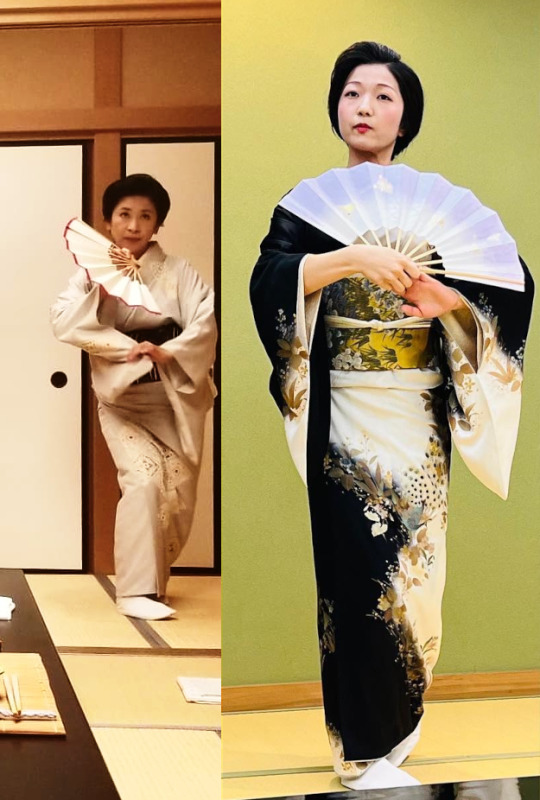
Others that you can also see in Ozashiki outside of Mukojima: ※ Ayame Yukata 菖蒲浴衣 ※ Echigo Jishi 越後獅子 ※ Hanami Odori 花見踊り ※ Hatsuharu 初春 ※ Ina bushi 伊那節 ※ Kiyari Kuzushi 木遣りくずし ※ Sawagi さわぎ ※ Setsuhonkaina せつほんかいな ※ Shichi fukujin 七福神 ※ Takeda bushi 武田節 ※ Tatsumi no hidarizuma 辰巳の左褄 ※ Tsurukame 鶴亀 ※ Yakkosan 奴さん ※ Yoshiwara Suzume 吉原すずめ
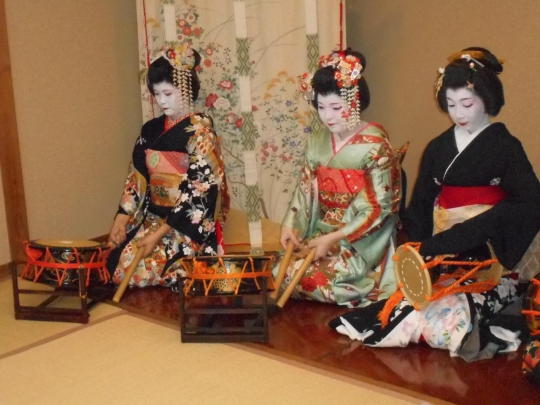
Notes Mukojima allows part-time workers, calling them Kamome かもめ [5]. Most of them are students or work in a different job already. Their task is mainly assisting Geisha/Hangyoku in the Ozashiki. Kamome can become Hangyoku or Geisha if they wish to work full-time. Mukojima dancers also play instruments at ozashiki: Hangyoku frequently play shime-daiko, Tachikata more often play ko-tsutsumi, sometimes fue. Shamisen seems so be reserved for Jikata.
Usually, Ryotei and Okiya are separate businesses in Tokyo. In Mukojima, however, several Ryotei also function as Okiya [3], similar to how in Kyoto, several Ochaya also have an attached Okiya.

Sources - Text [1] Foreign Press Center Japan, Mukojima Press Tour April 2006 https://fpcj.jp/en/assistance-en/tours_notice-en/p=6744/ [2] https://www.flickr.com/photos/blue_ruin_1/28442353867/ [3] numbers 1906-1951, 1996-2007: Sumi Asahara "Tokyo Rokkagai", 2007 [4] not an exact number (account required) https://www.tapatalk.com/groups/tsurukomaiko/hanamachi-population-reference-wip-t2000.html [5] Kamome http://sengoku-japan.com/ [6] dances compiled at Tsurukomaiko, it's by no means a complete list (account required) https://www.tapatalk.com/groups/tsurukomaiko/list-of-dances-in-all-hanamachi-t1988.html [7] 1993: Tsuiseki (追跡): The World of the Geisha, ca. 1993 https://www.youtube.com/watch?v=bkhRWNDwTyM Sources - Pictures Omomo ※ Kingyo Ozashiki ※ Momoka ※ Komachi ※ Yuki+Otokichi ※ Chikage ※ Senyume ※ Hiroya ※ Chikage+Natsuki ※ Tamaki ※ Shingetsu ※ Natsuki (twitter) ※ Soraka (insta) ※ Tomoka ※ Kingyo (fb) ※ Teruka 2x ※ Kanzashi ※ Kintaro (insta) ※ Ayame ※ Kingyo+Rin Ozashiki (fb) ※ Sakura matsuri 2023 I tried to trace back all pictures. If you find the missing links, let me know. "The look of" other Hanamachi: Yamagata, Tokyo Yoshicho, Niigata, Atami, Gifu, Tokyo Kagurazaka, Arima Onsen, Tokyo Asakua, Nagoya, Tokyo Shinbashi, Anjo I Osaka Kitashinchi, II Tokyo Akasaka, III Osaka Nanchi, Fukuoka, V Yuzawa, VI Morioka More Mukojima content: https://maigeiko.tumblr.com/tagged/mukojima Layout: @geimaiko, thanks as always! ♥
75 notes
·
View notes
Text
What’s That Thing? Part 26
On The Second Day of Fun I present... another recent ask! This one is really informative and I was eager to save it for this series ^^ Anonymous asked: “Could you please tell us more about pre-sakkō hairstyles in Pontocho?” Pontocho goes through a wide variety of hairstyles during the pre-sakko period. This is just one way to show that a big change for a big commitment is coming. The pre-sakko stage of hairstyle changes usually lasts for 2 months, in which a maiko goes through approximately 4-6 different hairstyles, each being worn for 1-2 weeks on average. The following is a list of the various styles that are worn during this time: Edo Sakkō 江戸先笄
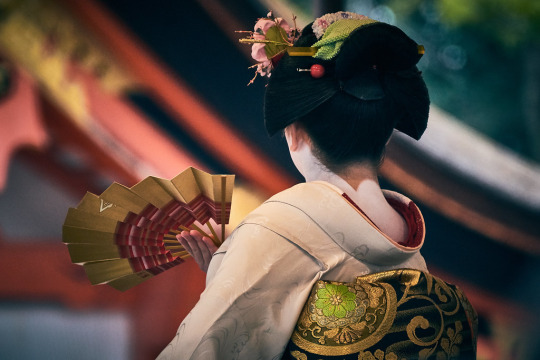
Image courtesy of Afrigole. A slight variation on the traditional sakkō hairstyle, it features a colorful kanoko with a bekkō kogai inserted through the center. It harkens back to the old Edo hairstyles that involved the punctuation of bekkō kogai throughout the hair. This style is also worn during Setsubun. Suisha 水車
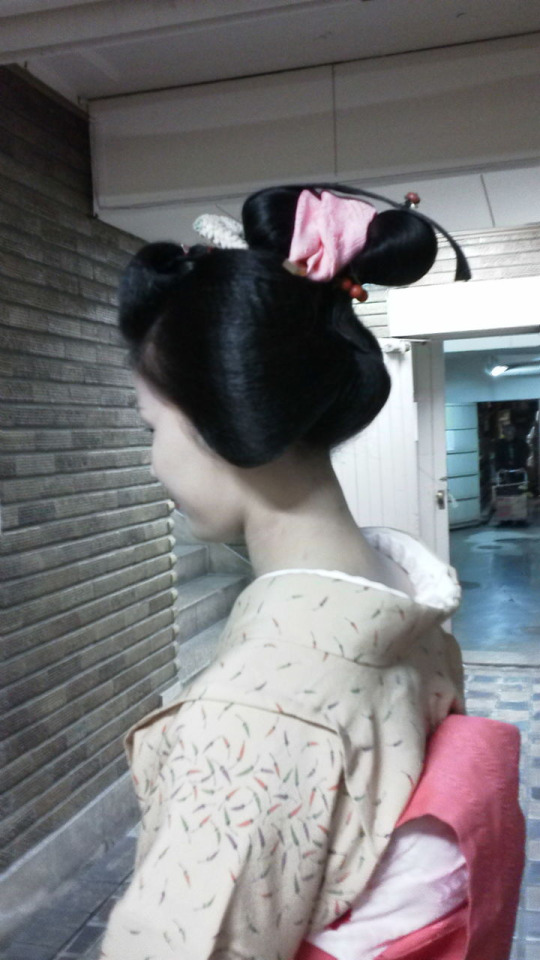
Image courtesy of Sakuchan. A more complex hairstyle that also features a kanoko and a kogai, it’s a cousin of the oshidori style. It’s accented underneath with a string of tama kanzashi that match the current season (red for October to May and green for June to September). While rare, it can be seen sometimes during Setsubun. Mitsumage 三つ髷
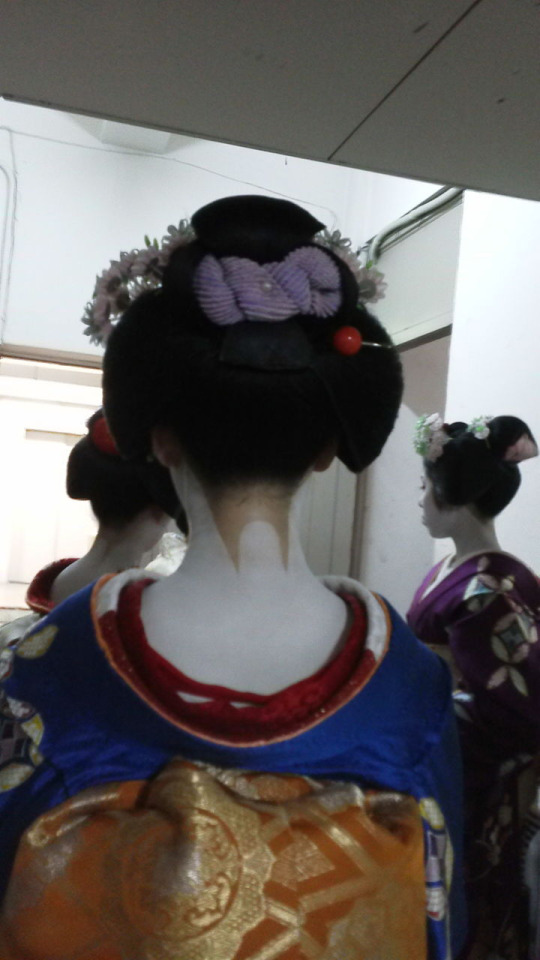
Image courtesy of Sakuchan. One of the rarer pre-sakkō styles, it’s defined by its upright mage and twisted knot kanoko found pinned at the base. Although it can be worn during Setsubun, I have yet to see a maiko do so. Yuiwata 結綿
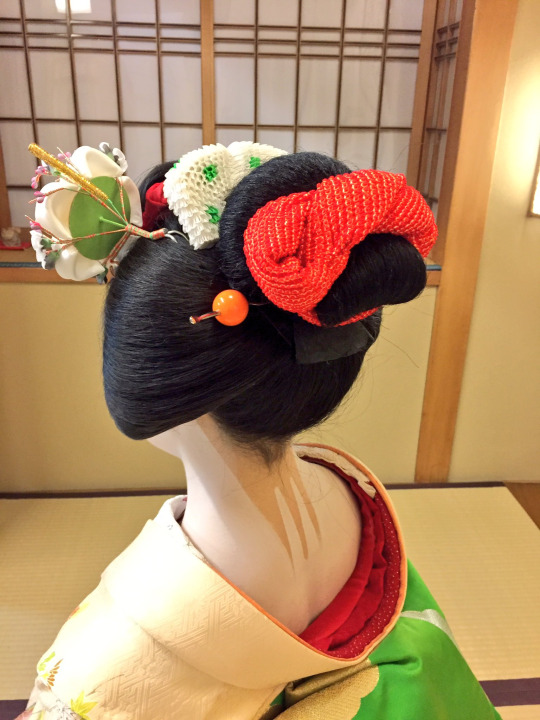
Image courtesy of Yoshifumi. One of the classical Edo hairstyles, it’s characterized by a high mage that’s then tied with a knotted kanoko. The kanoko is usually red, but other colors can sometimes be seen. This is a somewhat popular style with senior maiko during Setsubun. Kikugasane 菊重ね
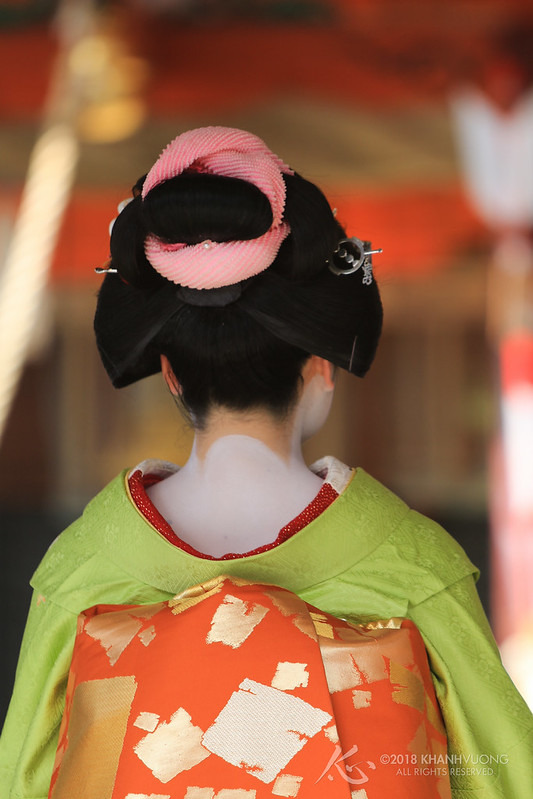
Image courtesy of Crazy Blue Panda. A more intricate version of yuiwata, the kanoko in this case is tied through the mage as well as around it. Like the others, you can find it worn during Setsubun, but only by the most senior of maiko. Oshidori - Mesu おしどり雌
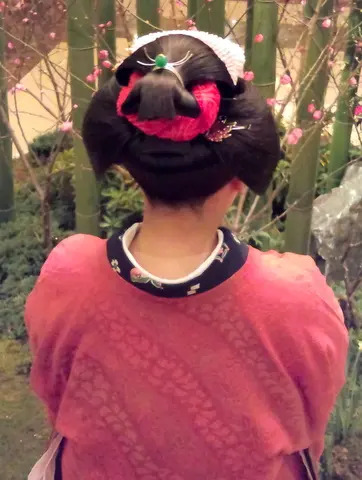
Image courtesy of Haginon. Another rare style, it’s simple in its execution with a lengthened mage tied together and topped with a tama kanzashi and finished off with a kanoko tied underneath. It’s also very rare during Setsubun. Oshidori - Hina おしどり雛
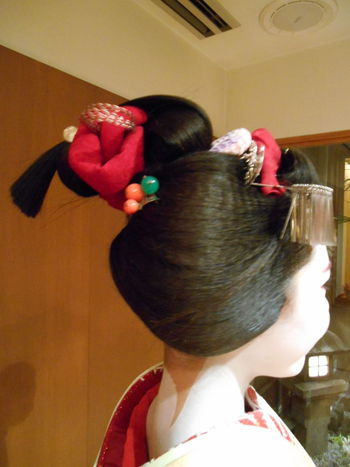
Image courtesy of Shigemori. One of the most popular styles due to its intricacy and iconic look, oshidori hina is known for its knotted kanoko that’s tied through the middle of the mage that’s accented by shiraga tonbo tied through the middle of the kanoko! It’s like the turducken of styles! It’s also extremely popular during Setsubun and can be worn by both maiko who are about to be senior and senior maiko alike. Oshun お俊
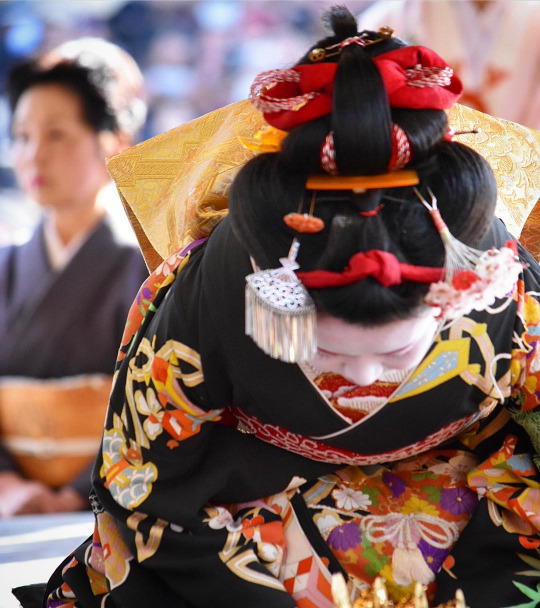
Image courtesy of Toshiworth. Very similar to oshidori hina, it adds a kanoko through the top part of the mage along with shiraga tonbo tied in and an ichidome bar holding down the hair extention. It can also be found during Setsubun, but is not as popular as its oshidori cousin. Osafune 長船
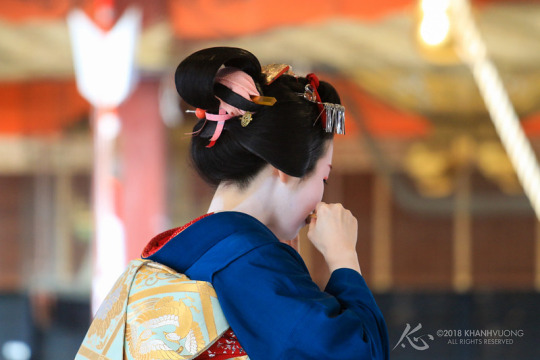
Image courtesy of Crazy Blue Panda. The most complex style that’s also an iconic Edo Period style, osafune adds in thin nemaki on top of kanoko and a bekko kogai to make a truly intricate work of art. During Setsubun it is worn by only the most senior maiko in each district as a sign of seniority.
#maiko#geiko#geisha#kyoto#hairstyles#pontocho#edo sakko#suisha#mitsumage#yuiwata#kikugasane#oshidori#oshun#osafune
81 notes
·
View notes
Note
Do Hangyoku ever wear Hikizuri. If they do, how come and when do they wear them? It'd be lovely if you could maybe make a post about how Hangyoku's appearance changes on seniority! :3
There's three Hanamachi where I've seen where Hangyoku wear Hikizuri: - in Hakata/Fukuoka (not sure what the occasion is) - in Mukojima/Tokyo for Mukojima Odori, if their role requires it - and in Kagurazaka/Tokyo, this year the current only Hangyoku wore a Maiko Hikizuri for Setsubun There's some cases outside of Kyoto where apprentice Geisha wear Hikizuri on a more regular level, but they call themselves "Maiko". As for how Hangyoku's appearance changes with seniority - that's actually very simple. A transition in little details from junior to senior like in Kyoto doesn't happen, mostly there's no difference at all. However, there's two exceptions: In Mukojima, around half a year before her Erikae, Hangyoku's wig hairstyle changes from Momoware to Yuiwata. She will no longer have her own hair styled (junior Hangyoku in Mukojima usually do both - own hair Nihongami and Katsura) and wear simpler Kanzashi than before (for example, Katsuyama Kanzashi gets exchanged for a Kushi).

In Kagurazaka, in the last year of apprenticeship, Hangyoku's hairstyle changes to Yuiwata and her Haneri is mostly white.

22 notes
·
View notes
Text
Kamisuwa Onsen, collected random infos
Back in March, a reader of this blog asked for a blog entry in the vein of previous "the look of..." features, but for Kamisuwa Onsen 上諏訪温泉. Sadly, there isn't much visual material available and the basic look of the 3 or less remaining Geisha boils down to: Yohatsu, Homongi, light-coloured Obiage, Otaiko Musubi, or the formal look: Tsubushi Shimada, Kurotomesode, red Obiage, Otaiko Musubi. So here, I present some collected random infos you might find interesting.
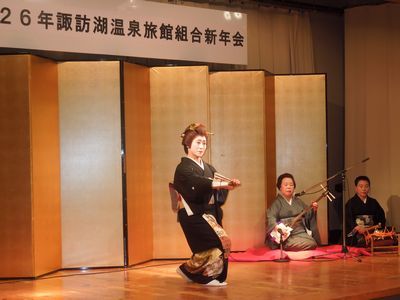
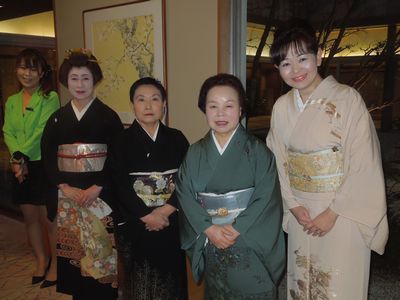
Kamisuwa Geisha, Setsubun 2014
Dances Kappore かっぽれ Takeda bushi 武田節 Kiso bushi 木曽節 Kohan bushi 湖畔節 Ina bushi 伊奈節 Shôchikubai 松竹梅 (performed in the new year season) Tsurukame 鶴亀 (performed at wedding receptions and birthdays) O-Suwa Takashi お諏訪節 Sukêto bushi スケート節 (Ice skating on lake Suwa) Kirigamine kouta 霧ヶ峰小唄 (ice skating) Onhashira kouta 御柱小唄 Suwa ondo 諏訪音頭 (about the beauty of Suwa throughout the seasons) Okaya kouta 岡谷小唄 (about the Okaya silk industry) Numbers 1930's ("early Showa period"): 200 Geisha in Kamisuwa 1958: 80 1960's: 300 2006: 3 History The first Hanamachi on lake Suwa developed in Nawatemachi 縄手町/畷町 in 1903 (renamed to Otemachi 大手町 in 1909). In the following years, a few Ryotei were established. In 1920, the area of Otemachi 1 and 2 chôme was designated as area for Geisha, so Okiya and Ryotei of the neighbouring Izumichô area 和泉町 were moved there. In the early Showa period (1920's/30's), Okiya that were formerly located in Hamamachi also moved to Otemachi. Kamisuwa had two kenban: Ote kenban 大手見番 and Koyanagi kenban 湖柳見番. In Shimosuwa 下諏訪, it seems kenban had no specific names. In Okaya 岡谷, there used to be another Koyanagi kenban 小柳見番 in the Honmachi area. In Chino 茅野, there were Miyagawa kenban 宮川見番 (current Miyagawacho area), and Eimei kenban 永明見番 (current Nakacho area). Before the around 1969/70, Geisha of these respective cities did not work in other cities. But with the decline of Geisha numbers, the Hanamachi in Okaya, Shimosuwa and Chino were no longer able to meet the demands of their customers, so it was allowed for Geisha from Kamisuwa to pad those numbers.
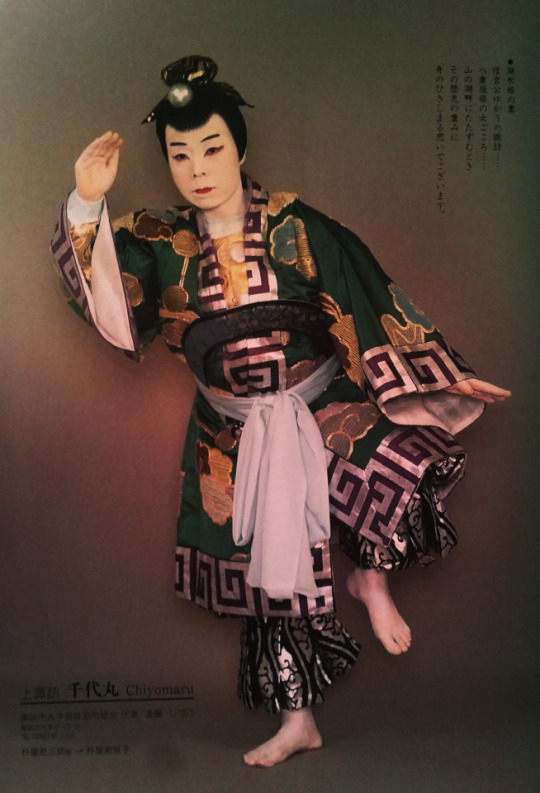
Chiyomaru 千代丸 in "Showa Meigiren", 1988 Daily life Geisha usually practiced their respective arts (such as Narimono, Nagauta, Kouta, dance) until 15:00, afterwards they went to the beauty parlour to get their hair done, put on makeup and change into work clothes. Ozashiki usually lasted for two hours. Style In the year 1935, Geisha still wore their natural hair instead of wigs, and their hairstyle changed, depending on rank and age. Hangyoku wore Momoware 桃割れ and Oshidori おしどり. Geisha under 26 years wore Yuiwata 結い綿 or Taka shimada 高島田, no info on Geisha between 26 and 30, Geisha aged 31 and above wore Geiko yui 芸こ結い, tsubushi (shimada?) つぶし, icho gaeshi 銀杏返, and yokai maki 夜会まき. Around 1955, most Geisha wore short hair or western updos on a daily base and used Nihongami wigs for work. Becoming Geiko Three mediators who acted as go-between of Okiya and families/volunteers worked in Kamisuwa. According to Manchiyo, who worked from 1930 to 44 in Otemachi, the daughters of poor farmers and travelling entertainers were sold to the Okiya for 15 yen. When the parents met with the Okiya, the length of the girl's service was decided. After becoming employed by the Okiya, the girls were doing "odd jobs", while taking lessons in Hanayagi-ryu dance, Shamisen and other arts. It's like Shikomi in Kyoto, although no specific term is named. When a Hangyoku was ready to become a Geisha, she had to prove her skills in dance or shamisen to a council of dance/shamisen teacher, Okiya owner, senior Geisha, head of the Geisha association and a member of the Kenban. The Okiya spent around 30 yen for an Erikae, while the Geisha had to take a loan of 150-200 yen. If her parents were to borrow money during her time before becoming independent, it was added to her loan. If parents continued to ask for money and the Geisha's debt became too large, they often became prostitutes in order to pay off their debts. Around 2 years after becoming Geisha, they became "Goshugi tori" ご祝���取り - they receive some of the money from the Gyokudai, but tips were entirely for them to keep. The next level was called "share" 分け, when 40% of all earnings were her own. When becoming independent from their Okiya, they paid fees for food and being registered at the place. Most Geisha also had a patron after becoming independent, which also lead to most of them retiring before the age of 30. @gardengeisha yes, this is about Kamisuwa Onsen located in Suwa-gun in Nagano prefecture!
Sources: https://www.saginoyu.com/blog/10090 (2014) 地方花柳界における〈芸〉と〈色〉諏訪湖沿岸 地域の事例 (2015) 花街文化伝える学校が開校/長野・上諏訪温泉 (2008) はなあかり: 昭和名妓連 (1988)
42 notes
·
View notes
Note
hii! i'm a bit curious of the previous post about the higashiyama onsen hangyoku, how come her obi is taiko? i assume she's wearing yuiwata since she's close to becoming a geisha, however... why? is it common for geisha to also work in snack bars like that? thank you ^^
Hello there o/ I assume that dressing rules in Higashiyama Onsen are more like "house rules" of each Okiya. Since there are only two Okiya with Hangyoku, it's easy to see (so easy, yet I never noticed before...): Let's start with Hanayoshi 花佳. Here's a picture of Chiyono 千代乃, uploaded on twitter in 2014. You can see she's wearing Yuiwata and Taiko musubi. Since I don't really know when she debuted, it could have been taken in her first or last year of being a Hangyoku...
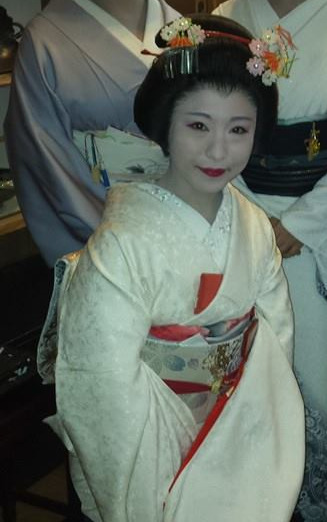
My oldest picture of Fuyuka 冬華, together with one of her younger sisters, probably March 2019. Both wear Yuiwata and Taiko musubi:
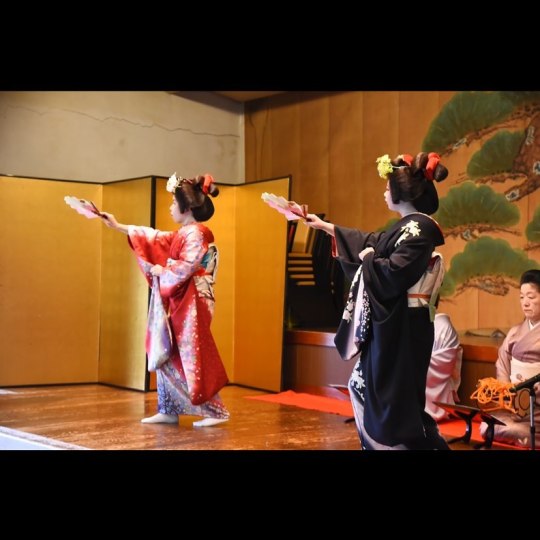
And another one - Kotono 古都乃 on the day of her debut. Wearing Yuiwata? Check. Wearing Taiko musubi? Check.
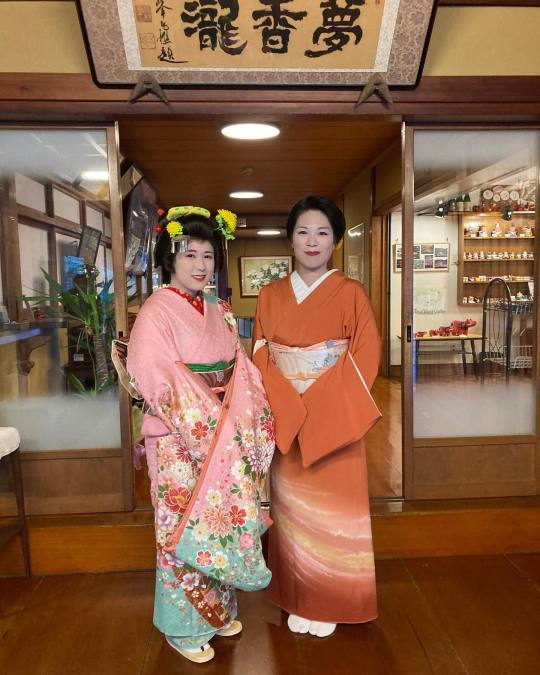
Now, let us proceed to Hananoya 花の家. Mai 真衣 was a Hangyoku from around 2006-09. Momoware and kôken musubi.
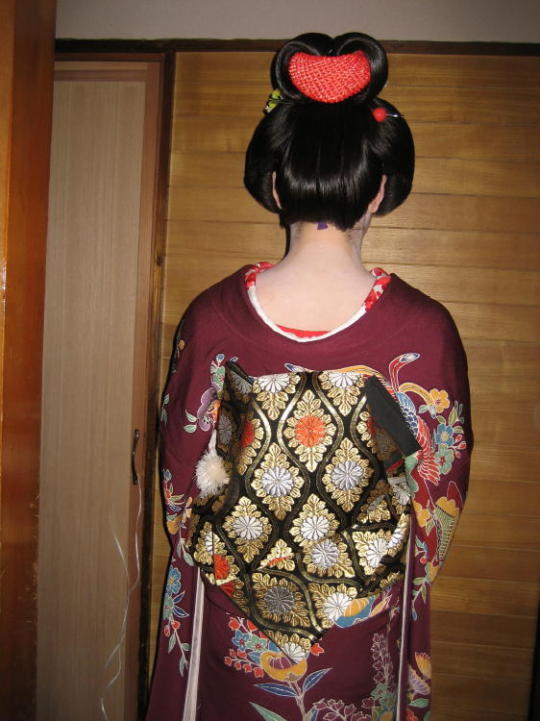
After her, Hananoya didn't have a Hangyoku until Iori 伊おりin August 2023. Unlike those who debuted before her, she has her own hair styled (I think it's Hanaogi mage 花扇髷) and wears kôken musubi like Mai. She recently had a katsura fitting (Momoware), so I'm curious if she will continue to have her own hair styled, or start wearing katsura regularily in future.
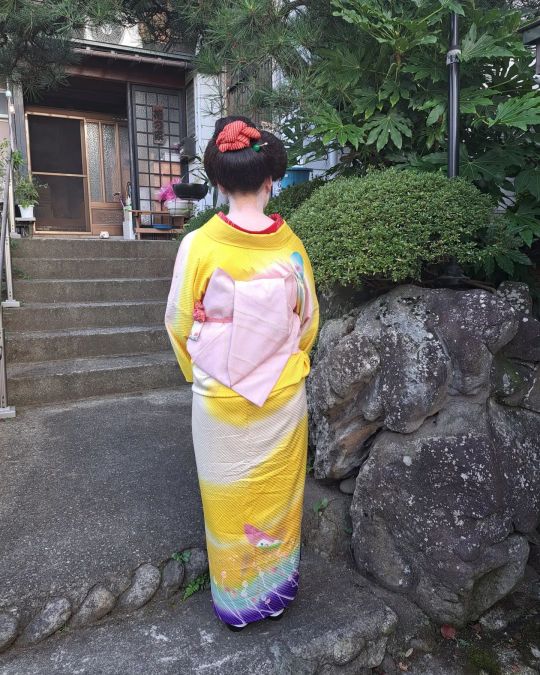
As for the snack bar. Good question. Perhaps it's owned by someone close to the Hanamachi, a regular customer? It is an extra opportunity of generating income in times of low demand for Ozashiki. Noboru のぼる, a Geisha/Okasan from Tokyo Omori said in an interview in 2020, that some of her employees work in snack bars, when there are no Ozashiki. It's not clear to me if this was separate from their Geisha job, or a part of it.
17 notes
·
View notes
Photo

Senior Hangyoku Momoka (桃加) from Mukojima wearing a Katsura styled in Yuiwata in April 2012. Apart from the unusual hairdo (only used for senior Hangyoku in Mukojima), she also wears Okobo, which is fairly rare for Tokyo Hangyoku - mostly, they wear Zôri.
Momoko became a Geisha that year and is still working in Mukojima! Photo source: Cliff CLF on flickr
42 notes
·
View notes
Photo
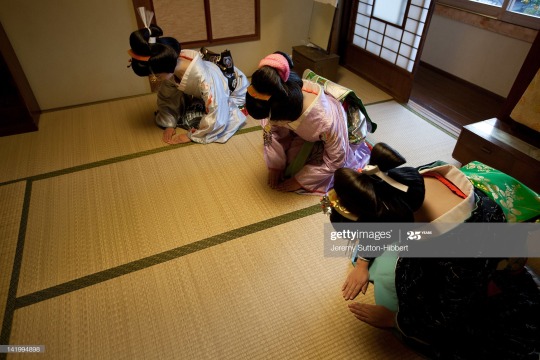

Shimoda Geisha photographed by Jeremy Sutton-Hibbert in December 2011. Awagiku (in white), Iroha (in pink) and Rinka (in black) debuted as Geisha in March 2012. On the second photo, you can see Hanamaru (in purple) with them, a senior Geisha. The style of the Shimoda Geisha is quite eclectic - you can see, they wear two different types of Kimono: the Geisha to debut wear Hikizuri Hanamaru wears Hômongi ... three different types of Katsura: Awagiku and Hanamaru wear Geisha Shimada with long wires that have feathered ends - other city’s Geigi and bride’s Taka Shimada wigs have wires that are usually a bit shorter and much narrower Iroha wears Yuiwata Rinka wears Tsubushi Shimada ....and four different Obi Musubi: Hanamaru wears Taiko Musubi Awagiku wears Bunko Musubi Iroha wears Yanagi Musubi Rinka wears Tsunodashi Musubi There are also Maiko in Shimoda (I don’t know what the regional term is). Visually, their main difference from the Geisha are the bright, modern Furisode they wear and the wig decoration. A lot of features are shared with the Geisha: white collar, tied Obiage, Yuiwata wig, Taiko Musubi Obi.
#Shimoda#MG#onsen geisha#tsunodashi musubi#Yanagi Musubi#2011#december#Awagiku#Iroha#Rinka#Hanamaru#tsubushi shimada#yuiwata
40 notes
·
View notes